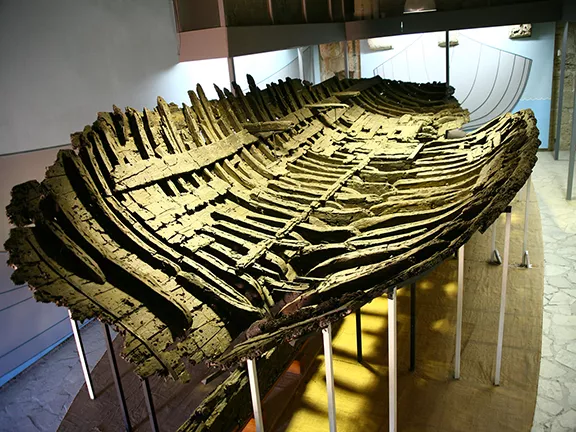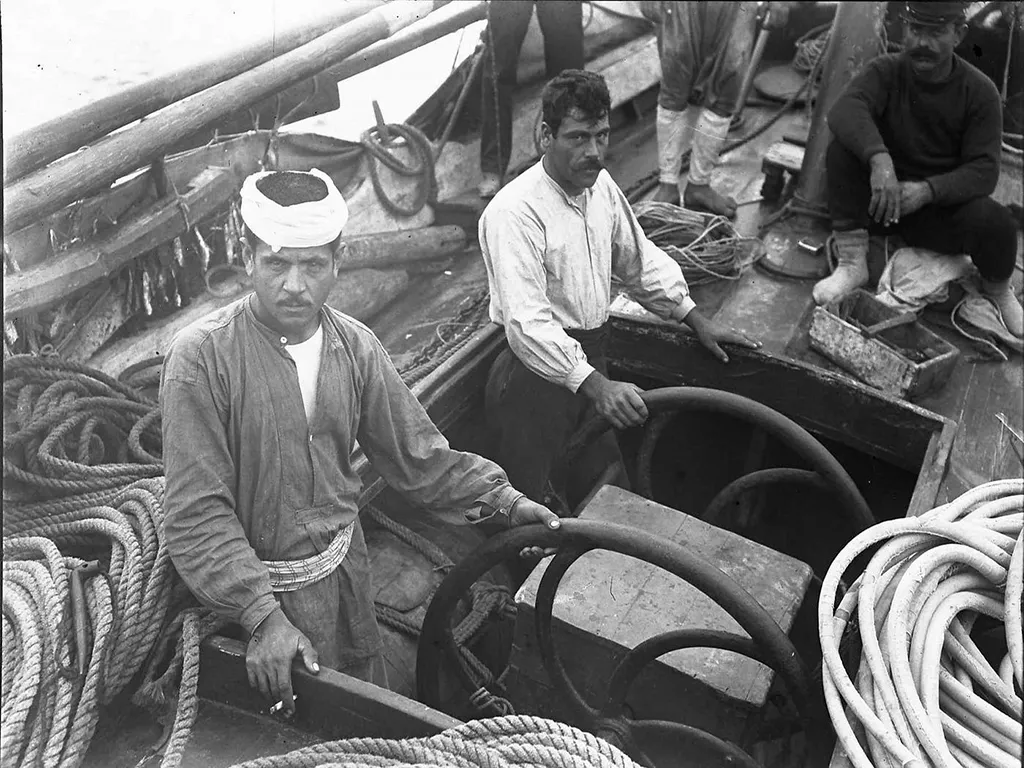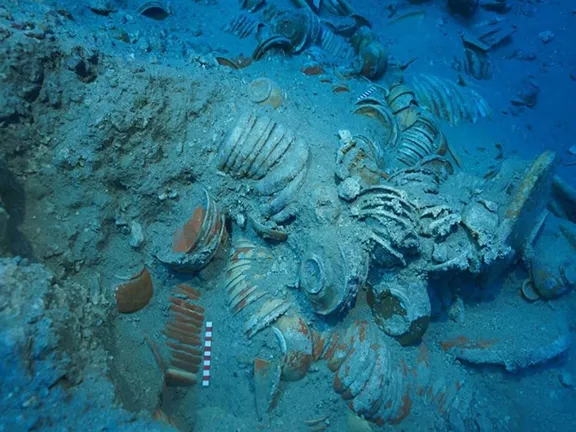Roman Era Shipwrecks in the Mediterranean
Marsala Punic Warship Shipwreck
Was the Marsala a Punic warship sunk at the Battle of the Aegates Islands in 241 BC? This crucial Roman victory against the Carthaginian fleet ended the First Punic War.
By Nick Nutter on 2025-11-2 | Last Updated 2025-11-17 | Roman Era Shipwrecks in the Mediterranean
This article has been visited 136 times

Diving on the Marsala wreck
Discovery and Excavation History
Local knowledge and accidental finds initiated the history of the Marsala wreck's discovery. In 1969, a sand dredger operating off Isola Lunga, near Marsala on the western coast of Sicily, uncovered unusual timbers. The dredger captain, Diego Bonini, alerted local enthusiasts, which subsequently led to the involvement of authorities.
In 1970, maritime archaeologist Honor Frost and her team, acting under a mandate from the Sicilian authorities and the British School at Rome, undertook an initial survey. Although the initially reported wreck had disappeared beneath shifting sands, a broader investigation revealed scattered finds, including a spearhead, a warship-type anchor, and potential fragments of a corvus (a Roman boarding device that was basically a plank of wood with a hook at the outboard end that could be dropped between two combatting ships to allow foot soldiers to board the enemy vessel), all suggesting a military context.
The major breakthrough occurred in 1971 when a systematic line survey led to the discovery of a large timber, later identified as the sternpost of a vessel, exposed by shifting sands. This launched a four-year, intensive excavation campaign led by Honor Frost. The excavation involved meticulous underwater work, documenting and recovering a substantial portion of the hull structure, along with associated artefacts. The wreck was recovered, conserved, and reconstructed, ultimately going on public display in Marsala in 1986. The work of Frost and her team was pioneering, as they were likely recovering the remains of the first ancient military galley ever fully discovered and studied.
Do you enjoy my articles? For your reading pleasure, this website does not carry third party ads. You could help me write more articles by buying me a cup of coffee.
Construction: A Hellenistic Warship
The Marsala vessel exhibits characteristics of the dominant Hellenistic architectural system, which is based on a "shell-first" construction method.
Shell-First Construction: The planks (strakes) of the hull's outer skin were assembled and joined together first, creating the shell. Shipwrights then installed the transverse internal frames (floor timbers and half-frames) secondarily, primarily for reinforcement. Evidence from the Marsala wreck, including the pattern of bolted floor timbers, confirms this approach, which differed from later "skeleton-first" construction where the internal frame determined the hull's shape.
Coagmenta Punicana(Mortise-and-Tenon Joints): The integrity of the shell relied on an intricate and closely spaced network of mortise-and-tenon joints that fastened adjacent planks edge-to-edge. This technique, inherited from Phoenician tradition and sometimes referred to as the "Phoenician joint" (coagmenta punicana), was critical to creating the hull's strength and water tightness before the internal frames were added.
Materials and Dimensions: Shipwrights used pine and aceraceous wood to construct the hull, resulting in a sleek, hydrodynamic form essential for a warship. Its straight keel measured approximately 30 metres, giving an estimated overall length of nearly 35 metres and a width of 4.8 metres.
Hull Protection and Military Features: The vessel was found to have been covered with lead sheathing below the waterline. This protection, while common on merchant ships to deter marine borers, offers an interesting military parallel. Furthermore, the construction of the sternpost suggested it was designed to break on impact, a mechanism that would allow the vessel to disengage quickly after using a ram.
Dating and Sinking
Archaeological and scientific analysis places the wreck squarely within the context of the First Punic War.
Punic Attribution: Punic inscriptions (shipwrights' marks) found carved into the timbers definitively attributed the vessel to the Carthaginians.
Chronology: Carbon-14 dating of the wood suggested a date of around 235 BC plus or minus 65yrs, while epigraphic analysis of the Punic markings indicated a construction date between 300 and 260 BC.
Date and Destination: The prevailing hypothesis connects the sinking to the Battle of the Aegates Islands in 241 BC. This crucial Roman victory against the Carthaginian fleet ended the First Punic War. The wreck’s location near Marsala (ancient Lilybaeum) strongly suggests the vessel was either heading to or from the major Carthaginian naval base during the campaign. Therefore, the cargo's likely destination was implicit in its military role: the war zone or a base of operations.
Cargo and Analysis
The Marsala wreck exhibited a distinct lack of traditional trade cargo, a characteristic that strongly supported its identification as a warship. The items recovered represented provisions and shipboard equipment, rather than freight.
Provisions: Excavators recovered various types of butchered meat intended for the rowers and crew, including venison, horse, beef, mutton, goat, and pork. Utilitarian ceramic crockery, designed for individual use, was also found.
Unique Find (Source Analysis): A unique discovery involved fragments of marijuana stalks. Researchers suggest the oarsmen may have chewed these for their psychoactive properties, potentially aiding endurance during extended rowing periods. While the ship's material culture (pottery, wood inscriptions) points to a Punic origin, the source of these unique provisions remains an ongoing subject of research.
Equipment: The finds included a warship-type anchor, fragments of rope and a basket, and, potentially, fragments of a corvus. Poignant evidence of the vessel’s fate included the human bones of a person seemingly trapped beneath the wreckage.
Pioneering Conservation Techniques
The conservation of the Marsala wreck was a pioneering effort, necessary to stabilise the fragile waterlogged wood, particularly the less-durable pine and aceraceous species.
Stabilisation: After recovery, the timbers underwent desalination in freshwater tanks to remove corrosive salts. The primary stabilisation method involved impregnating the wood with polyethylene glycol (PEG), a water-soluble wax. The PEG replaced the water in the wood cells, preventing the timbers from shrinking and collapsing upon drying.
Documentation: Crucial to the long-term preservation and study was the team's meticulous documentation, including the creation of durable plaster casts of key structural elements like the stern and keel.
Modern Assessment: More recently, high-resolution 3D laser scanning has been employed to create a comprehensive digital model. This process assists conservators in monitoring the ship's current condition and developing future preservation and exhibition strategies.
Significance of the Punic Inscriptions on the Marsala Warship
The Punic inscriptions found carved into the timbers of the Marsala warship are arguably one of the most significant aspects of the discovery, as they provide unequivocal evidence of Carthaginian origin and offer rare, tangible insight into ancient shipbuilding practice and labour organisation.
Punic Markings: Identification and Language
The markings consist of letters from the Punic alphabet, a variant of the Phoenician script used in Carthage and its colonies. Honor Frost's analysis identified these markings as shipwrights' marks.
Attribution: The script immediately and definitively confirmed the vessel was of Carthaginian (Punic) construction. This settled the national identity of the ship, which sank in an area heavily contested by both Rome and Carthage during the First Punic War.
Dating: Epigraphic analysis of the script’s paleography—the style of the handwriting—allowed Frost and others to narrow the ship's construction date to between 300 and 260 BC, aligning perfectly with the conflict period.
Insight into Shipbuilding Labour
The inscriptions were not just random graffiti; they served a clear, practical function within the shipyard, revealing details about the construction process:
Assembly Guides: Shipwrights carved the letters and symbols onto the timbers (planks, ribs, and other structural pieces) while they were still in the shipyard. These marks acted as assembly guides, directing the workmen on where to place each specific piece.
Quality Control/Team Identification: The inscriptions may have functioned as a system for quality control or for identifying the specific work crews responsible for cutting and preparing sets of timbers. By matching the marks, different teams could ensure that their pre-cut pieces—designed to fit together in the "shell-first" method—were properly matched and aligned during the final assembly of the hull.
The Punic inscriptions transform the Marsala warship from merely a wreck into a "talking text", offering direct, non-literary evidence of the advanced organisational and technical capabilities of the Carthaginian navy at the height of its power.
Where can the Marsala Shipwreck remains be seen?


The Marsala Punic Shipwreck is on permanent public display at the Museo Archeologico Regionale Baglio Anselmi in Marsala, Sicily, Italy.
The museum is located right on the coast and was built around the conserved remains of the vessel, which are its most famous exhibit.
References & Further Reading
1. Frost, Honor. (1981). The Punic Ship: Final Excavation Report. Accademia Nazionale dei Lincei. (The foundational work on the excavation and interpretation).
2. Steffy, J. Richard. (1994). Wooden Ship Building and the Interpretation of Shipwrecks. Texas A&M University Press. (Provides technical context on 'shell-first' and mortise-and-tenon joints).
3. Honor Frost Foundation (Various Publications/Online Resources). (Excellent source for excavation photos, conservation details, and Frost's notes).
Do you enjoy my articles? For your reading pleasure, this website does not carry third party ads. You could help me write more articles by buying me a cup of coffee.
 1: The Komiža Shipwreck (400 – 300 BC)
1: The Komiža Shipwreck (400 – 300 BC) 2: Kyrenia Shipwreck 295 – 285 BC
2: Kyrenia Shipwreck 295 – 285 BC 4: Mahdia Shipwreck 80–70 BC
4: Mahdia Shipwreck 80–70 BC 5: Antikythera Shipwreck 60 - 50 BC
5: Antikythera Shipwreck 60 - 50 BC 6: Adrasan Plate wreck c 50 - 20 BC
6: Adrasan Plate wreck c 50 - 20 BC